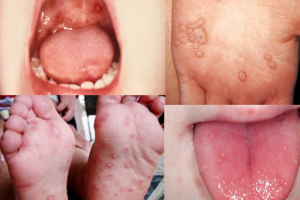Authors: Derick Tompkins III (M3 University of Kentucky College of Medicine); Jordan Boggs, DO (PGY-3 Emergency Medicine University of Kentucky College of Medicine); Patrick Grace MD (Assistant Professor Emergency Medicine University of Kentucky College of Medicine) // Reviewed by: Jessica Pelletier, DO (EM Education Fellow, Washington University in St. Louis); Alex Koyfman, MD (@EMHighAK); Brit Long, MD (@long_brit)
Case:
A 28-year-old G1P0 female at 14 weeks gestational age presents to the Emergency Department with one hour of palpitations and tachycardia. Her heart rate is 145 bpm, blood pressure is 98/65 mmHg, respiratory rate of 22, and has an oxygen saturation of 95% on room air. Her electrocardiogram (EKG) is below. Which medications are safe to use in pregnancy for this medical condition?

Introduction:
Maternal mortality rates have been steadily increasing in the United States for many years now. According to the CDC, in 2018 there were an estimated 17.4 maternal deaths per 100,000 births; 2018; 20.1 in 2019; 23.8 in 2020 and 32.9 in 2021. (1) Out of these maternal deaths, an estimated 12.1% are caused by cardiomyopathy, while 14.5% are caused by other cardiovascular conditions. (2) More specifically, a retrospective study performed between 2002 to 2011 found that arrhythmias accounted for 10.7 % of maternal death. (4, 5) New-onset benign arrhythmias are discovered in more than 50% of pregnant women, while malignant tachycardias are found in 0.3% of the population. (3) With the increasing rates of mortality, managing these conditions properly in the emergency department is incredibly important. Pregnant mothers need special consideration for medications and cardioversion because of fetal health. This article will serve as a review of the types of tachyarrhythmias, how a pregnant patient might present in the ED and the management of each condition.
Pathophysiology/Electrophysiology:
Cardiovascular physiology goes through many changes during pregnancy, including hemodynamic, adaptive changes, and autonomic changes. (11) Systemic vasodilation becomes detectable as early as 5 weeks, and plasma volume continues to increase until 34 weeks. (6,10) This is due to maternal vasculature and maternal kidneys preparing to support placental circulation. (6, 7) In addition, there is an expected increase in cardiac output and heart rate, and a decrease in systemic vascular resistance (SVR) and mean blood pressure (MBP). (8) With the changes the maternal body undergoes, this explains a possible reason pregnancy is associated with an increased risk of developing arrhythmias. (9) Due to these changes, we can anticipate ECG changes as well. Examples of ECG changes in a normal pregnancy are QRS shift, ST-depression and T-wave inversion in inferior and lateral leads, Q-wave and inverted T-wave in lead III, and atrial and ventricular ectopic beats. (10,11) Benign arrhythmias may be due to idiopathic causes, sepsis, toxins, or hormonal imbalances. (14) Concerns for life threatening arrhythmias could be a result of underlying structural heart conditions. Taking an accurate and detailed cardiac history is very important when interviewing this patient population.
The most common type of arrhythmias that presents in pregnancy are supraventricular tachycardia (SVT). (11) One type of SVT, paroxysmal supraventricular tachycardia (PSVT) is the most common that presents in women without underlying cardiac history. (12) Most frequently, atrioventricular nodal reentrant tachycardia (AVNRT) and atrioventricular reciprocating tachycardia (AVRT) are the most frequent manifestations. (11) Following PSVTs, atrial fibrillation and flutter are the next most frequent. (13) Ventricular arrhythmias are also possible during pregnancy, occurring more commonly in women with underlying structural heart diseases. (11)
Benign arrhythmias are more common than life threatening ones, however all concerns of arrhythmias warrant a workup in the emergency department. Important screening questions for tachycardia include asking about a history of palpitations, chest pain, breathlessness; known for heart conditions in the patient or family; diagnosed arrhythmias; symptoms of infection; hypercoagulable autoimmune disorders. (15) Following these questions, the patient may require more workups including blood tests or ECG. For the rest of this review, the differential diagnosis of pathologic tachyarrhythmias will be discussed and the treatment plans that are most optimal for managing this patient population in the emergency department.
Supraventricular Tachycardia:
SVT is one of the most common arrhythmias in pregnancy and is defined as a tachyarrhythmia with a heart rate > 120 beats per minute. (16) SVT has a prevalence of 24 per 100 000 hospital admissions, and approximately 20% of patients with pre-existing SVT will experience symptomatic exacerbations during pregnancy. (22) SVT can present at any stage of pregnancy, including labor. (19) Reentry is the main mechanism of SVT either via AV nodal reentrant tachycardia or AV reentrant tachycardia, with development of cases 60% and 30%, respectively. (17) The frequency of SVT increases in pregnancy in those with underlying structural or congenital heart disease, although in most cases there is no history of heart disease. (18) The recurrence rate during pregnancy in women with a history of supraventricular tachycardia is 50%. (26) It is proposed that physiological changes in pregnancy including increased maternal effective circulating volume, increased adrenergic receptor sensitivity, and increased circulatory levels of catecholamines are mechanisms that increase the frequency of SVT. (17) These physiological changes occur more drastically in the first trimester, which is during the first thirteen weeks of pregnancy. (19)
Vagal maneuvers are the first line treatment for acute termination of SVT. Vagal maneuvers include Valsalva, carotid sinus massage, and facial ice immersion. However, when vagal maneuvers fail, the trimester of pregnancy should be considered when approaching pharmacological management of SVT. It is important to consider a therapy that will prevent adverse effects on the fetus. (19) Adenosine is safe in all three trimesters and is therefore the first line pharmacological treatment. Adenosine is most used in management, with conversion to NSR in 84% of cases after failure of vagal maneuvers. (18) IV adenosine has a half-life of 10 seconds and is unlikely to enter fetal circulation. (19)
Beta-blockers, such as propranolol and metoprolol, and digoxin are second line for acute treatment. These medications are safe in the first trimester. Atenolol must be avoided in first trimester pregnancy as it results in intrauterine growth restriction. (19) Calcium channel blockers, such as diltiazem and verapamil, are third line in treatment. Verapamil should be avoided in the first trimester of pregnancy as it can cause fetal bradycardia and heart block.
Electrical cardioversion needs to be considered in drug-refractory or hemodynamically unstable patients. Synchronized electrical cardioversion is safe and should be administered initially at 50-100 J, with energy applied up to 400 J. (20)
It is important to consider pre-excitation syndromes such as WPW with pharmacologic treatment of SVT. Various pharmacological treatments can increase conduction over the accessory pathway and place the patient at risk of developing ventricular arrhythmias. Flecainide and procainamide can be used for acute termination of SVT in WPW. For long term suppression of SVT, prophylaxis with flecainide can be used. AV nodal blockage should be used with caution for long term suppression of SVT in pre-excitation syndromes given risk of conduction over accessory pathway. (21)
Lastly, amiodarone should be avoided in management of SVT during pregnancy. Amiodarone is associated with IUGR in the first trimester. The chronic use of amiodarone is associated with congenital goiter, hypo/hyperthyroidism, and fetal QT prolongation and therefore should not be used long term. (19)
Atrial Fibrillation and Atrial Flutter:
Atrial fibrillation (AF) and atrial flutter are uncommon arrhythmias in childbearing age. These arrhythmias can occur with structurally normal hearts but often occur in structural heart disease. There is a prevalence of 2 in 100 000 hospital admissions with AF and atrial flutter (22). In the Registry of Pregnancy and Cardiac Disease between 2008 and 2011, 1.3% of 1,321 pregnant women with congenital, valvular, and ischemic heart disease developed atrial fibrillation or atrial flutter. (23) Women with mitral valve disease have a higher incidence. Only 0.7% of women with congenital heart disease developed AF/atrial flutter. The recurrence rate during pregnancy in women with a history of paroxysmal AF/Aflutter is 52%. (26)
It is important to consider and rule out underlying conditions that may cause new onset atrial fibrillation or atrial flutter. These include thyroid disease, pulmonary embolism, electrolyte abnormalities, and alcohol abuse. (21) A transthoracic echocardiogram may be beneficial to assess for structural heart disease. (21)
For acute and chronic management of AF and atrial flutter, rate control with beta blockers, CCB, or digoxin have been tolerated and is appropriate for most patients. (22)
Beta blockers including metoprolol and labetalol are the recommended initial treatment for rate control in hemodynamically stable patients. Metoprolol is safe during breastfeeding and has been a more effective agent lowering rate with comparison to labetalol. In women with mitral valve disease such as mitral stenosis, beta blockers allow for longer diastolic filling time and improved hemodynamics in the mother. (23) Calcium channel blockers can also be used for rate control. IV verapamil is often held because of the risk of neonatal and/or maternal hypotension. PO verapamil is often used instead of IV verapamil. Digoxin has been most effective when used in combination with other agents. (23) Oral digoxin is considered safe during lactation as it is excreted into the breast milk at extremely low concentrations. As mentioned above, amiodarone should be avoided in acute management given risk of fetal harm. (22)
If rate control fails or the patient has poorly tolerated episodes of AF (such as a patient with mitral stenosis), anti-arrhythmogenic medications, such as sotalol or flecainide, are preferred in this setting. (22) Sotalol therapy may be limited by fetal bradycardia, maternal QT interval prolongation, and potential life-threatening arrhythmias. Use of this medication requires close maternal monitoring. (23)
Catheter ablation is deferred in pregnancy for atrial fibrillation or flutter until the post-partum period. (21, 22)
Electrical cardioversion is the treatment modality for hemodynamically unstable patients and should be performed within 48 hours of onset to reduce stroke risk. (21) Pregnancy is a prothrombotic state, and anticoagulation needs to be considered. Patients with mitral stenosis should be fully anticoagulated. (21) LMWH or unfractionated heparin are the preferred agents for anticoagulation, especially in the first trimester and last month of pregnancy. (21,22) Heparin can be used when cardioversion is planned in refractory/persistent cases. Warfarin may be used during the second and third trimesters. (22)
The CHA2DS2-VASc is a common risk stratification tool used in the ED for stroke risk for patients with atrial fibrillation. This tool does not account for the prothrombotic physiology or arrhythmogenic state of pregnancy. The CHA2DS2-VASc score underestimates the risk of systemic thromboembolic events in pregnant women with pre-existing or newly diagnosed AF or AFL. (24)
Ventricular Tachycardia:
Ventricular tachycardia and ventricular fibrillation are rare in pregnancy, with a prevalence of 2 per 100,000 admissions. (25) Ventricular arrhythmias most often occur in patients with underlying structural heart disease and history of VT. The recurrence rate during pregnancy with women with a history of ventricular tachycardia is 27%. (26)
Structural heart disease can be described in pregnant patients with cardiomyopathies such as hypertrophic cardiomyopathy and ischemic cardiomyopathy. (22) Ischemic cardiomyopathies are uncommon, but myocardial infarctions occurring late in pregnancy had the greatest maternal mortality. (27) Peripartum cardiomyopathy should be considered in patients without known structural heart disease who develop symptoms of heart failure in the last month of pregnancy or in the one-to-two-month postpartum period. (22) The risk of ventricular tachycardia in patients with congenital heart disease is high with a prevalence of 4.5 to 15.9 per 1000 pregnancies. (21)
For the acute treatment of ventricular tachycardia, electrical cardioversion should be performed in hemodynamically unstable patients. This should be performed emergently given the risk of fetal compromise. Electrical cardioversion is performed at 50-100 J, but energy up to 400 J can be applied. (20,21) In hemodynamically stable patients, treatment with lidocaine or beta blockers is used. (22) Procainamide or quinidine may be used if lidocaine is ineffective but should not be used if VT is caused by myocardial ischemia or coronary artery disease as there is an association with increased mortality in nonpregnant patients with structural heart disease. (28) Metoprolol and labetalol are the beta-blockers recommended for treatment. Sotalol may be considered if another beta blockage is ineffective. (22)
Nonstructural or idiopathic VT is associated with a good prognosis. (29) Treatment with beta blockers is effective as VT without structural disease is often catecholamine sensitive. (21) Beta blockers can be continued throughout pregnancy and in the postpartum period. If beta-blockers fail, sotalol or flecainide can be considered for treatment. (22)
Patients with Torsades de Pointes or polymorphic VT can be safely treated with IV magnesium.
Ablation may be performed but is considered a last resort. This is typically deferred to the post-partum period. (21)
Medication Considerations in Pregnancy:
Most antiarrhythmic drugs are FDA category C, meaning that risk of the fetus cannot be ruled out. The FDA rates drugs from A to X (Table 1). (21) The main concern when administering medications in pregnancy is the potential risk to the fetus. The fetus is most sensitive to teratogens in the first trimester as organogenesis is occurring.
Table 1.

The potential benefit of stabilizing the patient may outweigh the risks of administering medications to control significant arrhythmias and must be considered with the acute treatment of the tachyarrhythmias discussed in this review. As pregnancy progresses to the second and third trimesters, fetal growth, fetal development, fetal arrhythmias, and uterine contractility need to be considered when choosing treatment.
Table 2 shows characteristics of common antiarrhythmic medications administered in pregnancy including FDA risk category, potential adverse effects, and use during lactation. (22)
Table 2.

Take-Home Points:
- Maternal tachyarrhythmias are a rare but serious complication related to structural and physiologic changes that accompany pregnancy.
- While most rhythm changes are benign, hemodynamic instability can be associated with supraventricular tachycardia, atrial fibrillation, atrial flutter, and ventricular tachycardia.
- Vagal maneuvers, adenosine, and beta blockers should be considered first in supraventricular tachycardia.
- Beta blockers are the preferred agent for rate control in atrial fibrillation and atrial flutter over calcium channel blockers.
- For stable ventricular tachycardia, lidocaine and beta blockers are the preferred pharmacologic treatments.
- In all unstable tachyarrhythmias, electrical cardioversion is safe and effective.
- Make sure to avoid amiodarone use in pregnancy, preferring the use of lidocaine as your first line antiarrhythmic.
References:
- Maternal mortality rates in the United States, 2019Personal Author(s) : Hoyert, Donna L. Corporate Authors(s): National Center for Health Statistics (U.S.). Division of Vital Statistics. Published Date: 04/01/2020 Series: NCHS health E-Stats: https://stacks.cdc.gov/view/cdc/103855
- Pregnancy Mortality Surveillance System: https://www.cdc.gov/reproductivehealth/maternal-mortality/pregnancy-mortality-surveillance-system.htm
- Adamson DL, Nelson-Piercy C. Managing palpitations and arrhythmias during pregnancy. Heart. 2007 Dec;93(12):1630-6. doi: 10.1136/hrt.2006.098822. PMID: 18003696; PMCID: PMC2095764.
- Tamirisa, K, Elkayam, U, Briller, J. et al. Arrhythmias in Pregnancy. J Am Coll Cardiol EP. 2022 Jan, 8 (1) 120–135. https://doi.org/10.1016/j.jacep.2021.10.004
- Briller, Joan et al. “Maternal Cardiovascular Mortality in Illinois, 2002-2011.” Obstetrics and gynecology vol. 129,5 (2017): 819-826. doi:10.1097/AOG.0000000000001981
- Sanghavi M, Rutherford JD. Cardiovascular physiology of pregnancy. Circulation. 2014 Sep 16;130(12):1003-8. doi: 10.1161/CIRCULATIONAHA.114.009029. PMID: 25223771. https://www.ahajournals.org/doi/10.1161/CIRCULATIONAHA.114.009029?url_ver=Z39.88-2003&rfr_id=ori:rid:crossref.org&rfr_dat=cr_pub%20%200pubmed
- [’Jose Luis Merino’, ’A Perez-Silva’]. (n.d.). Tachyarrhythmias and pregnancy. European Society of Cardiology. https://www.escardio.org/Journals/E-Journal-of-Cardiology-Practice/Volume-9/Tachyarrhythmias-and-Pregnancy
- Tamirisa, K, Elkayam, U, Briller, J. et al. Arrhythmias in Pregnancy. J Am Coll Cardiol EP. 2022 Jan, 8 (1) 120–135. https://doi.org/10.1016/j.jacep.2021.10.004 https://www.jacc.org/action/showCitFormats?doi=10.1016/j.jacep.2021.10.004
- Soma-Pillay P, Nelson-Piercy C, Tolppanen H, Mebazaa A. Physiological changes in pregnancy. Cardiovasc J Afr. 2016 Mar-Apr;27(2):89-94. doi: 10.5830/CVJA-2016-021. PMID: 27213856; PMCID: PMC4928162. https://www.ncbi.nlm.nih.gov/pmc/articles/PMC4928162/
- Ananthakrishnan, R.; Sharma, Shradha1,; Joshi, Sudhir; Karunakaran, Sandeep2; Mohanty, S.. ECG Changes in Pregnancy – An Observational Study. Journal of Marine Medical Society 22(2):p 187-192, Jul–Dec 2020. | DOI: 10.4103/jmms.jmms_6_20 https://journals.lww.com/jmsc/fulltext/2020/22020/ecg_changes_in_pregnancy___an_observational_study.17.aspx#O3-17-3
- Safavi-Naeini P, Sorurbakhsh NZ, Razavi M. Cardiac Arrhythmias During Pregnancy. Tex Heart Inst J. 2021 Sep 1;48(4):e217548. doi: 10.14503/THIJ-21-7548. PMID: 34669954; PMCID: PMC8717750. https://www.ncbi.nlm.nih.gov/pmc/articles/PMC8717750/#:~:text=Types%20of%20Arrhythmia%20During%20Pregnancy&text=Paroxysmal%20supraventricular%20tachycardia%20is%20the,are%20the%20most%20frequent%20manifestations.
- Baig, M. “Arrhythmia-centered treatment review of tachyarrhythmia during pregnancy.” EJournal of Cardiology Practice 12 (2014): 13. https://www.escardio.org/Journals/E-Journal-of-Cardiology-Practice/Volume-12/Arrhythmia-centered-treatment-review-of-tachy-arrhythmia-during-pregnancy#Ref8
- Salam, Amar M et al. “Atrial Fibrillation or Flutter During Pregnancy in Patients With Structural Heart Disease: Data From the ROPAC (Registry on Pregnancy and Cardiac Disease).” JACC. Clinical electrophysiology vol. 1,4 (2015): 284-292. doi:10.1016/j.jacep.2015.04.013
- Robertson, J. (2017, April 21). Tachycardic arrhythmias in pregnancy: Management. emDOCs.net – Emergency Medicine Education. https://www.emdocs.net/tachycardic-arrhythmias-pregnancy-management/
- Coad F, Frise C. Tachycardia in pregnancy: when to worry? Clin Med (Lond). 2021 Sep;21(5):e434-e437. doi: 10.7861/clinmed.2021-0495. Epub 2021 Aug 11. PMID: 34385298; PMCID: PMC8439506.
- Agrawal R, Shintre H, Rani B. A Rare Case of Supraventricular Tachycardia During Pregnancy and Successful Management in Crisis Situation with Electrical Cardioversion and Radiofrequency Ablation. J Obstet Gynaecol India. 2016 Oct;66(Suppl 2):594-597. doi: 10.1007/s13224-015-0836-0. Epub 2016 Mar 3. PMID: 27803517; PMCID: PMC5080247
- Ghosh N, Luk A, Derzko C, et al. The acute treatment of maternal supraventricular tachycardias during pregnancy: a review of the literature. J Obstet Gynaecol Can. 2011;33(1):17–23. doi: 10.1016/S1701-2163(16)34767-3.
- Silversides CK, Harris L, Haberer K, et al. Recurrence rates of arrhythmias during pregnancy in women with previous tachyarrhythmia and impact on fetal and neonatal outcomes. Am J Cardiol. 2006;97(8):1206–1212. doi: 10.1016/j.amjcard.2005.11.041
- Ibetoh CN, Stratulat E, Liu F, Wuni GY, Bahuva R, Shafiq MA, Gattas BS, Gordon DK. Supraventricular Tachycardia in Pregnancy: Gestational and Labor Differences in Treatment. Cureus. 2021 Oct 4;13(10):e18479. doi: 10.7759/cureus.18479. PMID: 34659918; PMCID: PMC8494174
- Yılmaz F, Beydilli I, Kavalcı C, Yılmaz S. Successful electrical cardioversion of supraventricular tachycardia in a pregnant patient. Am J Case Rep. 2012;13:33-5. doi: 10.12659/AJCR.882594. Epub 2012 Mar 9. PMID: 23569481; PMCID: PMC3615988.
- Page R.L., Joglar J.A., Caldwell M.A., et al. “2015 ACC/AHA/HRS guideline for the management of adult patients with supraventricular tachycardia: executive summary: a report of the American College of Cardiology/American Heart Association Task Force on Clinical Practice Guidelines and the Heart Rhythm Society”. J Am Coll Cardiol 2016;67:1575-1623.
- Enriquez, A. D., Economy, K. E., & Tedrow, U. B. (2014). Contemporary Management of arrhythmias during pregnancy. Circulation: Arrhythmia and Electrophysiology, 7(5), 961–967. https://doi.org/10.1161/circep.114.001517
- Salam A.M., Ertekin E., van Hagen I.M., et al. “Atrial fibrillation or flutter during pregnancy in patients with structural heart disease: data from the ROPAC (Registry on Pregnancy and Cardiac Disease)”. J Am Coll Cardiol EP 2015;1:284-292.
- Lindley, K., LoSapio, D., Conner, S., Billadello, J., Barger, P., & Cahill, A. (2018). Evaluation of CHA2DS2-VASC risk stratification tool in pregnant women with atrial fibrillation or atrial flutter. Journal of the American College of Cardiology, 71(11). https://doi.org/10.1016/s0735-1097(18)31037-4
- Li, J.-M., Nguyen, C., Joglar, J.A., Hamdan, M.H. and Page, R.L. (2008), Frequency and Outcome of Arrhythmias Complicating Admission During Pregnancy: Experience From a High-volume and Ethnically-diverse Obstetric Service. Clin Cardiol, 31: 538-541. https://doi.org/10.1002/clc.20326
- Silversides CK, Harris L, Haberer K, Sermer M, Colman JM, Siu SC. Recurrence rates of arrhythmias during pregnancy in women with previous tachyarrhythmia and impact on fetal and neonatal outcomes. Am J Cardiol. 2006 Apr 15;97(8):1206-12. doi: 10.1016/j.amjcard.2005.11.041. Epub 2006 Mar 3. PMID: 16616027.
- Hankins GD, Wendel GD Jr, Leveno KJ, Stoneham J. Myocardial infarction during pregnancy: a review. Obstet Gynecol. 1985 Jan;65(1):139-46. PMID: 3966016.
- Echt D.S., Liebson P.R., Mitchell L.B., et al. “Mortality and morbidity in patients receiving encainide, flecainide, or placebo. The Cardiac Arrhythmia Suppression Trial”. N Engl J Med 1991;324:781-788.
- Lemery R, Brugada P, Bella PD, Dugernier T, van den Dool A, Wellens HJ. Nonischemic ventricular tachycardia. Clinical course and long-term follow-up in patients without clinically overt heart disease. Circulation. 1989 May;79(5):990-9. doi: 10.1161/01.cir.79.5.990. PMID: 2713978





